Shevlin Sebastian's Blog, page 100
November 28, 2015
Shivering with Fear on a Bridge
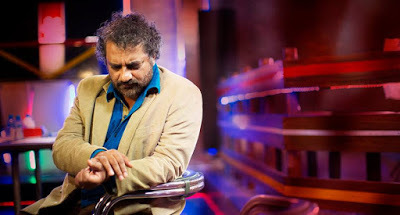 COLUMN: LOCATION DIARY
COLUMN: LOCATION DIARYActor Joy Mathew talks about his experience in the upcoming film, 'Mohavalayam'
By Shevlin Sebastian
One morning in November, actor Joy Mathew stood on top of a box on the edge of a bridge at the King Fahd causeway which connects Bahrain and Saudi Arabia. This was a scene from the upcoming film, 'Mohavalayam' by director TV Chandran. Joy was playing a film-maker called Jose Sebastian. In the climax, Joy was supposed to jump from the bridge, which is at a height of 200 feet, into the water.
The camera crew wanted to take a long shot. So they stood 600 metres away. “It was not possible to hear what they were saying,” says Joy. “They called me on the mobile phone. It was in my shirt pocket. But I could not take it.”
One reason was because Joy was shivering with fear. The cars and trucks on the four-lane causeway behind him were zipping past at speeds of 150 kms per hour. “It was causing a vibration,” says Joy. “I was finding it difficult to keep my balance.”
Suddenly, one of the drivers pressed the brake. “He thought I was going to commit suicide,” says Joy. “But he could not stop because there were other speeding cars behind him. This background screeching caused even more tension in me.”
Another cause for worry was that Joy did not know swimming. “If I fell into the water, there was very little chance that I would survive,” he says.
Meanwhile, Chandran kept calling Joy on the mobile phone. “So I decided to start acting,” says Joy. “But there was no need to do so. I was genuinely afraid. The expressions in the scene were natural.”
After the shoot was over, a relieved Joy jumped down from the stool. Within a few minutes, the Bahraini police arrived. Somebody had informed them that a suicide attempt was taking place.
“They asked me who had jumped,” says Joy. “I said, 'I am the person, but I did not jump. I am alive'.”
One of the officers said, “Are you mad?”
Joy said that he is an actor and the role demanded such an action.
One reason for the cops' worry was because it is a bridge where a lot of people had attempted suicide.
Then the police asked Chandran and Joy whether they had secured permission.
Indeed, permission had been taken. But it was to shoot near the bridge and not on it. “Since the police did not see me standing on the stool, it was okay,” says Joy.
That night, when Joy told his eldest son Mathew, about the incident, he said, “Please remember you have a wife and three children at home [in Kozhikode].”
'Mohavalayam', which will be released in January, 2016, is a story about the dreams and aspirations of Malayalees who reach Bahrain from Saudi Arabia, by crossing the causeway. The other actors include Maithili, Renji Panicker, Shine Tom Chacko, Siddique and Sudheesh.
(Published in The New Indian Express, Kochi, Thiruvananthapuram and Kozhikode)
Published on November 28, 2015 19:03
November 26, 2015
The Plight Of The Defeated
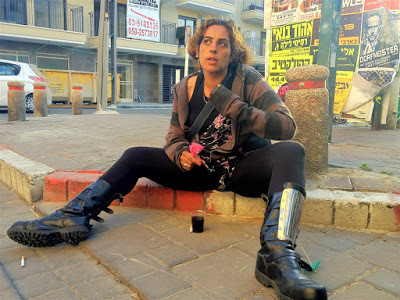
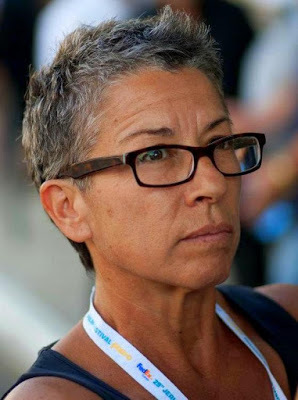 Israeli film-maker Claudia Levin focuses on the dispossessed in her documentary, ‘Bums – Go Home’
Israeli film-maker Claudia Levin focuses on the dispossessed in her documentary, ‘Bums – Go Home’ Photos: A still from the documentary; Claudia Levin
By Shevlin Sebastian
In 2011, social activist Claudia Levin came across a camp in her hometown of Tel Aviv where 2000 people were living in poverty.
“It was called the Lewinsky Garden Tent Camp,” says Claudia. “The media had ignored them, and many people in Tel Aviv did not know that such a place existed.”
Armed with a camera, Claudia spent several days there. And she was shocked to find that there were all sorts of people, ranging in age from 16 to 70.
“There were drug addicts, people suffering from sexually transmitted diseases, sex workers, victims of domestic violence, and the homeless,” says Claudia. “Some of them had lived for 40 years on the streets. There were also asylum-seekers from Sudan and Ethiopia. But the most interesting aspect was they all enjoyed a sense of community, even though they had nothing.”
Nevertheless, the film is an honest and unflinching look at the defeated people of society.
There is Rotem who had been a prostitute since the age of 11. She also takes drugs. And she walks around, with calipers, because of a damaged leg. She looks at the camera and says, “What can I do to get some peace of mind?”
Natan is pictured on a hospital bed where he tells the doctor that he had taken the drug cathinone for three days. “Then I threw myself into traffic at Levinsky Street,” he says. “I wanted to commit suicide.”
Meanwhile, the police think these are lazy and irresponsible people, who don't want to work.
“I told them, 'Guys, they are not like you and me',” says Claudia. “They don't do what we do. If we get up in the morning, we will wash our face and brush our teeth. But they will not do that. Firstly, they are trying to get some money, so that they can buy something to eat. So their mind-set is different. It is a parallel world.”
In the end, the police dismantle the camp. As they were doing so, one woman shouted, “You destroyed the only good thing in our neighbourhood.” Another man said, “Eight cops to arrest one girl: shame on you.” Later, the group gathers in a park, and one of them says, “We have to be strong. If not, we will be lost.”
Claudia became an advisor and confidant. “I told them they should get off the streets,” she says, at the Cinepolis, Kochi, where her documentary was being shown. “They should be aware of their rights, and try to get help from the government.”
But that turned out to be disappointing. “Very quickly it became clear that the bureaucracy did not have the ability nor the sensitivity to take care of street people,” says Claudia.
That was also the case with municipal inspectors, police, and workers at mental-care clinics and hospitals. “All of them were working independently of each another,” says Claudia. “Not only is there no single organisation to coordinate the care of the needy, they tended to compete with each other.”
So, she went to the Knesset and showed her documentary, 'Bums – Go Home' to the law-makers, to make them aware of the situation. “But they only said that they did not have any money to provide help,” she says.
However, by the end of the 56-minute film there are a few who manage to get jobs and a place to stay. “So, there are some positive stories,” says a smiling Claudia. “I am happy that I played a small part in this.”
(Published in The New Indian Express, Kochi and Thiruvananthapuram)
Published on November 26, 2015 20:25
November 25, 2015
An Inter-Religious Love
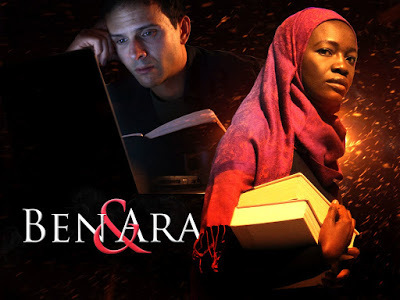
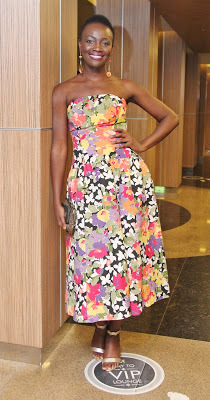 American actress Constance Ejuma talks about her film, 'Ben & Ara', which was shown at the All Lights India International Film Festival in Kochi
American actress Constance Ejuma talks about her film, 'Ben & Ara', which was shown at the All Lights India International Film Festival in KochiPhoto of Constance Ejuma by Albin Mathew
By Shevlin Sebastian
When American actress Constance Ejuma walked down the red carpet at the All Lights India International Film Festival at the Cinepolis, Kochi, she immediately caught the eye. Tall and slim, in an off-the-shoulder patterned dress, and gold stillettos, she had a style and grace of her own. This was the first visit to India for the Los Angeles native.
And she had come to show her first film, 'Ben & Ara', which stars upcoming actor Joseph Baird and herself.
The story is about an African Muslim woman, Ara, who falls in love with an agnostic man, Ben Johnson, a struggling doctoral candidate. “The film explores the tensions that arise as a result of their conflicting philosophies,” says Constance.
So, when Ara says, “My faith in Allah has been a source of strength and peace for me,” Ben replies, “I am an agnostic. I don't have a religion.”
Nevertheless, there is a mutual attraction, which Ara's mother observes and issues a warning to her: “We only experience love through Allah. This is going to make you an outcaste. You know that.”
But like any young woman, Ara wants the freedom to live the life that she wants. “And so even though Ara believes whole-heartedly in Islam there is a part of her that has a desire to go out into the world and explore,” says Constance. “She wants to be open to Western culture.”
Interestingly, unlike Ara, in real life, Constance is a practicing Buddhist. “I walked away from Christianity because I had too many questions, which it could not answer,” says Constance. “I was not experiencing the spiritual fulfillment that believers seemed to be experiencing. So, I became disenchanted and stopped going to church.”
Six years ago, a friend introduced her to Buddhism. “Buddhism is more about humanism than about worshipping a deity,” says Constance. “It is more about connecting with other human beings, nature and the environment we live in, and having respect for them.”
When she is in a low mood, Constance chants the mantra, 'Nam Myoho Renge Kyo'. “I always get peace of mind when I say it,” she says.
In Kochi, Constance found the Malayalis peaceful, open, and kind-hearted. “The food was different and tasty, while the weather reminded me a lot about Yaounde, Cameroon, where I was born,” she says.
Constance migrated from Cameroon, as a child, with her mother to America. When she grew up, she studied theatre at the University of Toronto and got a master's degree in mass communication from Leicester University in the UK.
Thus far, Constance has acted in theatre and television, and worked with artistic greats like Nobel Laureate Wole Soyinka and Academy Award Nominee Shohreh Aghdashloo.
Incidentally, 'Ben & Ara' received an Honourable Mention in the 'Best Feature Film' section at the Kochi festival. Earlier, the film was screened at a women's festival in Los Angeles. “Very soon, it will be shown in Beijing, China, and Marbella, Spain,” says Constance. “Later, we will be doing the film festival circuit.”
(The New Indian Express, Kochi and Thiruvananthapuram)
Published on November 25, 2015 21:00
November 24, 2015
Different From The Rest
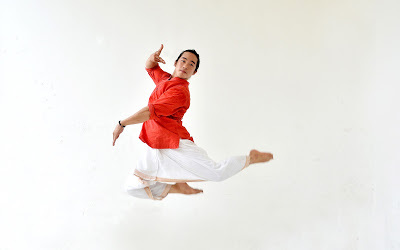
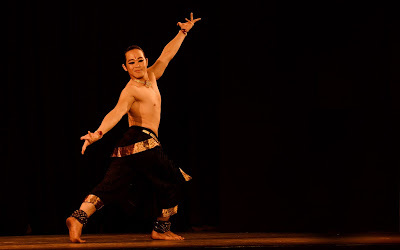 Charles Ma is perhaps the first, of Oriental origin, to become a Bharata Natyam dancer
Charles Ma is perhaps the first, of Oriental origin, to become a Bharata Natyam dancerPhotos by Ratheesh Sundaram
By Shevlin Sebastian
In 2007, when Charles Ma entered the venue for the dance competition during the Saarang fest at the Indian Institute of Technology in Chennai, it was overflowing with female participants. “There were 48 women and two males,” he says. “Many of the girls raised their eyebrows at me, wondering what I was doing there. A few cracked jokes.”
But there was a reason for their reaction. Charles has slanting eyes and is very fair. And that is because of his lineage. While his father is a mix of a Nepali Hindu and a Buddhist Chinese (the surname Ma is Chinese), his mother comes from Chinese and Naga origins. But Charles' parents have lived in Bangalore for several decades. “I am a South Indian by upbringing and influence,” he says. “I like my rice and sambar every day.”
At Chennai, Charles faced the mocking students with an impassive face. He took part and did get a round of applause from the audience.
The results were announced, in the usual order: first the third, then the second prize. “I realised that I stood no chance, but I was glad that I had participated, on behalf of Christ College, Bangalore, and did my best,” he says. “And then suddenly my name was announced. I had got the first place!”
Later, an excited Charles went up to the judge and asked why he had won. She gave a one-word reply: “Passion.”
In fact, passion also summed up Charles' performance at the recent Dharani Dance Festival at Kochi, as he moved across the stage in a fluid and elegant style, especially during the 30-minute varnam (a type of song).
One of Kochi's senior dance teachers and a former Kalashetra student, Girija Ravindranath says, “Charles is an extremely energetic and dedicated dancer. He was able to emote with his whole body rather than with just his face. He moved me and, I am sure, the audience as well."
Ever since he was 16 years old, Charles himself has been moved by the art form. “I don't know why I like Bharata Natyam,” he says. “But this passion burns inside me. I get up and sleep with the art form.”
Initially, he faced a lot of skepticism. “Somebody said, 'You have small eyes, how can you do Bharata Natyam?” says Charles. But one of his earlier teachers gave a fitting to reply to that. “It is not the size of the eyes that matters but the intention in it,” the teacher told Charles one day.
Indeed, Charles has a fighting spirit. “You can call me a white boy, you can say I have small eyes, you can say I cannot dance,” he says. “But I am not here to prove anything. I just want to show that I am as good as anybody else.”
Charles' life changed when he met Poornima Ashok who runs the Nrityanjali dance school. “She warmly welcomed me,” says Charles. “I have been training with her for the past nine years.”
But unlike most dancers, who perform at festivals and cultural institutions, Charles has been a favourite with the corporate crowd. “I do a dance performance as well as give a motivational talk,” he says. “I talk about failing and getting up, and how you can make impossible dreams come true. Like my own life: what was the possibility of me becoming a Bharata Natyam dancer? Through my talks, I want to make a difference in people's lives.”
In fact, Charles has giving rousing speeches at the highly-regarded TED India and Inktalks, as well as schools and colleges.
Once he went to Pesit College to give a performance. He did a theme based on Lord Shiva. “There is a mantra which I say, 'Om Namaha Shivaya',” says Charles. “It is a jaati (pattern) based on the panchakshara mantra.” 700 students clapped.
When he went home and opened his Facebook account, a student of the college wrote, “Namaskaram Sir, I never thought classical dance would bring tears to my eyes. Today your dancing did. And because of you, my life has been changed.”
Charles, 31, was moved by it. But he was not surprised by the reaction. “When I dance I am no longer Charles Ma,” he says. “Instead, I try to become a medium for the divine energy to flow through me.”
(Sunday Magazine, The New Indian Express, South India and Delhi)
Published on November 24, 2015 20:44
November 23, 2015
The Magic of the Man
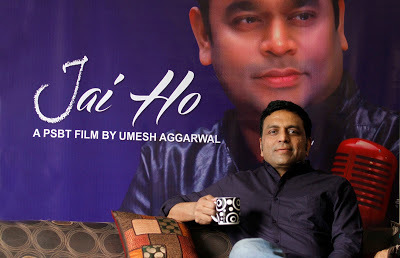 Umesh Aggarwal has made an absorbing 85-minute documentary called 'Jai Ho', on double Oscar winner AR Rahman
Umesh Aggarwal has made an absorbing 85-minute documentary called 'Jai Ho', on double Oscar winner AR RahmanPhoto by Satish Yadav
By Shevlin Sebastian
At 8.30 p.m. on October 28, Umesh Aggarwal went to the Toho theatre during the Tokyo International Film Festival. His 85-minute documentary film, 'Jai Ho', on double Oscar winner AR Rahman was being screened. But Aggarwal had no illusions. He expected about 10 people to view the screening. So, he got a shock, when he found the hall nearly full.
The audience watched raptly and when the songs were played, the Japanese hummed along. The ensuing question-and-answer session, which normally lasts 20 minutes, continued for 50 minutes. “The organisers had to step in, since another screening was scheduled,” says Aggarwal. The next two screenings were also well-attended.
“That's Rahman for you,” says Aggarwal. “He is a global icon.” Asked the reason why,Aggarwal says, “Rahman is able to mix Indian sensibility with Western technology. As a result, his songs have an international feel.”
Rahman has other qualities, too. Says British composer Andrew Lloyd Webber: “He is a most extraordinary melody writer. But he writes melodies in a way that a western composer can’t.”
The other talking heads, in this absorbing documentary, which is produced by the Public Service Broadcasting Trust, in collaboration with the Ministry of External Affairs, include Rahman's mother, Kareema Begum, sisters Fathima and Reihana, lyricist Gulzar, actor Aamir Khan, singers Hariharan and Alka Yagnik, and directors Mani Ratnam, Danny Boyle and Ramgopal Verma.
Verma recounted that the first time he heard the theme song of his film, 'Rangeela', both he and his cousin felt it was rubbish. So did his driver. But on the sets of the film, when he played it on the loudspeaker, by lunch time, everybody was humming the tune. Verma smiles and says, “Rahman always does a slow-poison on his listeners.”
But Aggarwal has also focused on Rahman the person and the turning points in his life. One day, when he was studying in Class 4, at the Padma Seshadri Bala Bhavan School, at Chennai, two teachers came up to him and said he had to go home. And when Rahman did, he received a jolt: his father RK Shekhar, a music composer, who had been ailing, had died, at the age of 43.
“Because of his father's death, Rahman began working at the age of 12, to support his family, and, at age 14, he had to stop his education,” says Aggarwal. “So you can imagine the struggle he has faced in his life.”
In fact, there is a poignant section when Rahman says that when his three children complained that he did not spend enough time with them, he told them, “You have a Dad. I did not have a Dad. Your Dad keeps travelling, but he always comes back. You have to see what we are blessed with. And not what we are denied.”
Aggarwal portrays, with affection and respect, Rahman's change of religion, from Hinduism to Sufi Islam, thanks to his mother's devotion to a pir, Karimullah Shah Qadri, his relaxed way of life in Los Angeles, and the creativity behind many of the songs. And all along, Rahman comes across as a down-to-earth person. “I have met many celebrities, but he remains unaffected by stardom and wealth,” says Aggarwal. “I am so glad that I made this film.”
And Aggarwal is also happy that, on November 29, the documentary will be the closing film in the Panorama section of the International Film Festival of India at Goa.
Jai Ho!
(A slightly different version appeared in the Sunday Magazine, The New Indian Express, South India and Delhi)
Published on November 23, 2015 21:00
November 22, 2015
A Whole Lot Of Crosses
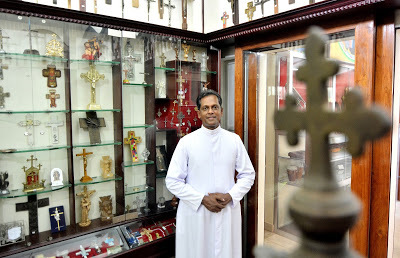
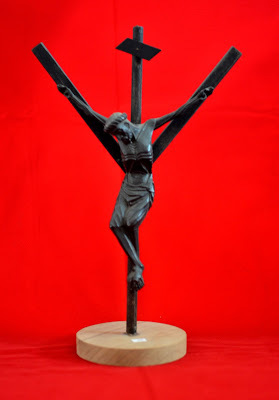 The St. Thomas Christian Museum, at Kochi, is a repository of 800 crosses, as well as historical items like drums, music instruments, and farming implements
The St. Thomas Christian Museum, at Kochi, is a repository of 800 crosses, as well as historical items like drums, music instruments, and farming implementsPhotos by Ratheesh Sundaram
By Shevlin Sebastian
One of the striking memories of Fr. George Alunkal's childhood was to see his great-grandfather, T. Ulahannan, walk about, with a large metal cross, around his neck. “Sometimes, it gleamed in the sunlight,” he says. “Whenever I looked at him, my eye would always go to the cross.”
When Ulahannan passed away, the cross was given to Fr. George's grandfather, who later gifted it to him when he decided to become a priest in 1972.
“I have been fascinated by crosses ever since,” he says. And it was during his days at the seminary that he began collecting crosses. Soon, other priests came to know about his hobby. “When any of them went abroad, they would bring me crosses,” says Fr. George. “When I went abroad myself, I would always be on the lookout. Invariably, when I returned, my suitcase would be full of crosses. I received most of them as gifts, but did purchase some antique crosses.”
Over the years, Fr. George steadily built up his collection, till it reached the staggering number of 657. The crosses were stored in two large cupboards in his vicar's room at the Cathedral Church in Kanjirapally. “I am growing old,” says the 66-year-old. “So, last year, I decided to donate it all to the St. Thomas Christian Museum at Kochi.”
And, indeed, at the Museum, the crosses present a pleasing sight. “There are all types of crosses,” says Dr. Peter Kannampuzha, the museum director. “They are made of porcelain, wood, metal, glass and crystal.” And the crosses have been brought from countries like the USA, Germany, Italy, Greece, Ethiopia, Iran, China and Indonesia.
The majority of the crosses show Jesus Christ on the crucifix. “But He is depicted differently,” says Fr. Peter. “So there is a black, white, and brown Jesus. Usually, the face is modelled on a local person. In societies where there are a lot of poverty and suffering, like in Africa, Jesus is portrayed as having a tragic face. In India, Jesus is mostly depicted in a joyful way because after he died, he had a resurrection. So they wanted to focus on that.”
Some crosses are unusual. There is one cross in the form of a tree, with a flower. “The flower shows the blooming of the earth after the death of Jesus,” says Fr. Peter. There is another where Jesus has been portrayed as a skeleton on the cross.
The museum has also got crosses donated by a lawyer, Jacob Cherupallikattu. “These include Papal, Cardinal and Patriarchal Crosses,” says Fr. Peter. All the crosses have been neatly displayed in wooden glass-framed cupboards.
The museum has been set up by the Syro-Malabar church, the largest branch of Christians in Kerala. “The aim of the museum is to promote, preserve and exhibit the heritage of the Thomas Christians in India,” says Cardinal George Alencherry. “It provides us with a sense of identity.”
So, apart from the crosses, there are 300-year-old farming implements, a traditional press, large clay jars, candlesticks, several types of lamps, old music instruments, traditional paintings and icons, as well as a huge Royal drum.
“This was placed on a bullock cart, and four people would bang on it,” says Bishop Pauly Kannookadan, chairman of the museum. “It was used for grand festival processions in the northern part of Kerala. Just before the king made an announcement, the drums would be played, to draw the attention of the crowd.”
There is also an audio-visual programme which narrates the history, from St. Thomas's arrival at Kodungallur, in 52 AD, all the way to the present. There are rare coins and books. One book is the 'Varthamanappusthakam', a Malayalam travelogue written by a priest called Paremmakkal Thoma Kathanar. “It is regarded as the first travelogue in an Indian language,” says guide Sr. Mereena. “It tells the story of a journey made by the author, along with Archbishop Mar Joseph Kariattil, to Rome and back.”
Nevertheless, it is the crosses which are the museum's most attractive feature. Ironically, Fr. George is yet to view the collection in the museum. “I am hoping to do so in the near future,” says the priest.
(Sunday Magazine, The New Indian Express, South India and Delhi)
Published on November 22, 2015 23:41
November 17, 2015
Chilled to the Bone and Scared
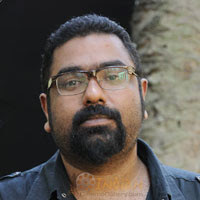
 COLUMN: Location Diary
COLUMN: Location Diary Director Amal Neerad talks about his experiences in the film, 'Anwar'
Photos: Amal Neerad; A still from the film, 'Anwar', starring Prithviraj and Mamta Mohandas
By Shevlin Sebastian
At 9 p.m. on a day in August, 2010, director Amal Neerad was travelling, with stars Prithviraj and Mamta Mohandas, in an Innova from the Rohtang Pass towards the Spiti Valley in Himachal Pradesh.
Amal wanted to shoot a song in a 'cold desert' at the town of Kaza, which is at a height of 11,000 feet. Behind their car were a few other Scorpios and Innovas carrying the rest of the 20-member crew.
It was cold. The temperature was 11 degrees Celsius. So they huddled in their pullovers and thick jackets. The cars were steadily going up a mountainside. However, a few minutes later, the convoy came to a shuddering halt.
It was an untarred road, consisting of sand, small rocky pebbles and stones. And a steady stream of water was flowing down the mountain, across the road and down the slope. “This flow is famous in the region,” says Amal. “It is called a 'paagal nala' and could become a raging torrent at any time. Many people had lost their lives because of this.”
What made matters worse was that the vehicles could not move. So they waited, not knowing what to do. “But the driver told us that the longer we waited, it would get worse,” says Amal. “So he advised us to walk.” And so the crew got down from their cars. It was dark all around, except for the headlights of the cars.
“We could not take the road,” says Amal. “So we walked on the shoulder, which was covered with snow. On the other side, was a steep drop.”
These were tense moments. There were fears that a flood could start at any moment. So they had to walk quickly. “Despite all this, Prithviraj and Mamta took it in a graceful manner,” says Amal.
After 25 minutes, they reached a place where the road became clear. “We were chilled to the bone,” says Amal. They managed to get a car and reached the town of Chhatru. Unfortunately, it was a small place. There were no hotels. So they had to settle down in dormitories.
Next morning, Amal decided he would picturise the song in and around Chhatru, rather than go to Raza. “The locations were picturesque enough,” he says.
However, while shooting in the cold, Mamta felt weak. “But not once did she complain,” says Amal. “She was a true sport.” Offering companionship to her was choreographer Gayatri Raghuram and her assistant.
It took three days before the song, 'Kanninima Nille', with music by Gopi Sundar, was picturised.
“When I look back, it was one of my most memorable experiences,” says Amal. And what might have warmed the director was that, after all the difficulties, the film did reasonably well at the box office.
(The New Indian Express, Kochi, Thiruvananthapuram and Kozhikode)
Published on November 17, 2015 20:13
November 15, 2015
The Dark Side of Life
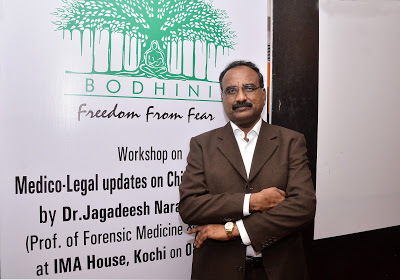
 Child sex abuse is still a scourge in Indian society. But new laws and proactive moves are helping victims, albeit in a small way
Child sex abuse is still a scourge in Indian society. But new laws and proactive moves are helping victims, albeit in a small wayPhoto of Dr. Jagadeesh N by Ratheesh Sundaram
By Shevlin Sebastian
One day, a mother took her 14-year-old daughter to a government hospital in Mumbai. The girl had been made pregnant by an uncle. It was a case of sexual abuse. Doctor Hiten Manjrekar (name changed) knew that if he did an abortion in a public hospital, it will be known to everybody. So he told the family to come to his clinic, where he promised to do the operation free-of-cost. At night, Manjrekar did the termination of pregnancy. However, the doctor did not do the mandatory reporting to the police.
Later, Manjrekar gave the foetus to the family and asked them to dispose it off. “That is because the foetus is difficult to get rid of, in Mumbai,” says the Bangalore-based Dr. Jagadeesh N, an expert on child abuse. “Bio-medical waste management rules are very strict.”
The family members stopped at a deserted road and were throwing the foetus into a gutter, when a mobile police van spotted the activity. “When the police discovered that it was a female foetus, they assumed it was a case of foeticide,” says Jagadeesh.
After interrogating the mother, the next day, they went to the hospital and met Manjrekar. “The doctor was asked why he did not do mandatory reporting and arrange for the proper disposal of the foetus,” says Jagadeesh. “And then the police discovered that the papers were made in the name of the girl's mother. So, Manjrekar was slapped with the additional charge of forgery. In a way, the doctor wanted to help the girl, but it backfired. This is an important lesson. One must always act legally and scientifically.”
Jagadeesh had come to Kochi recently to give a day-long series of talks.
In 2012, the landmark Protection of Children from Sexual Offences Act was formulated, in order to effectively address sexual abuse and exploitation of children. Thereafter, there have been amendments. And Jagadeesh wanted to inform stakeholders, like police officers, lawyers and doctors, about medico-legal updates at a seminar conducted by the NGO, Bodhini.
“Now, a doctor can examine a victim without permission from the police,” he says. “This is a major change. In the past, the victim had to initially go to the police station. Earlier, we were looking for evidence collection. But today treatment is a priority. Earlier, only government hospitals dealt with the victim, but now, any hospital can do so. There are uniform nation-wide guidelines issued by the Health Ministry.”
Today, the law also recognises that treatment is a must. “Even though there are no physical injuries, every case of abuse has a psychological impact,” says Jagadeesh. “That is why counselling is necessary. And it should be done on a long-term basis. That is the only way a child can resume a normal life again.”
Unfortunately, child sex abuse is still a major scourge. “It happens across all strata of society,” says Jagadeesh. “The maximum number of cases has been reported in the 10-18 year age group. In the upper classes, these cases are not reported, because people fear society's condemnation.”
Incidentally, the perpetrators, as is well known, are people who are close to the child. They include parents, uncles, teachers and family friends.
“The perpetrator does not sexually abuse everyone,” says Jagadeesh. “He will select a victim who is incapable of fighting back. For example, in domestic violence, the husband will beat his wife and not another man's wife.”
Asked as to why they do it, Jagadeesh says, “When sexual urges arise, the perpetrator tries to find whoever is available and vulnerable. He does not think that he is doing something wrong. Or that he will be punished. On the other hand, because he is in the grip of his perversion, he feels powerful.”
Meanwhile, Jagadeesh says that sex education should be imparted in all schools, be it private or government-run. “This should be done in a graded manner, at a primary, high-school and college level, so that there is an age-appropriate method to impart knowledge. Unfortunately, children are learning from wrong sources, like pornography on the Internet.”
But some remedial measures are in place. All Central Board of Secondary Education schools in the country are teaching students about good and bad touches. “Children are being taught that they can be touched in certain areas, and not in others,” says Jagadeesh. “Who are the people who can touch a child on the genitals? They include the mother, or a health-care provider, who is touching for a therapeutic reason. But he or she has to do it in the presence of the parents. If there is a bad touch, the child should immediately say no.”
And learn to get out of the situation. “The child can scream,” says Jagadeesh. “Or run to a public space. If a youngster can get away from the attacker into a public space, then it becomes safe for the child. Children should also tell their parents about bad touches, as soon as they occur.”
(The New Indian Express, Kochi and Thiruvananthapuram)
Published on November 15, 2015 20:58
November 13, 2015
A 3D Venture
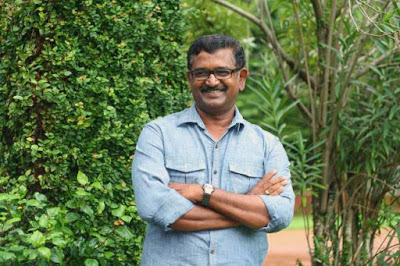
 Noted director Blessy is planning to make author Benyamin's best-selling 'Aadujeevitham' (Goat Days) as a 3D film, with Prithviraj in the leadBy Shevlin SebastianThe moment director Blessy finished reading Benyamin's 'Aadujeevitham' (Goat Days), in 2008, he was certain of one thing: he wanted to make a film based on it. “I was particularly attracted to the visual images that came through while reading the book,” he says. “What I also appreciated was the way that it portrays human values. Every human being goes through the same struggles in life.”'Aadujeevitham' is the story of Najeeb Muhammad, an emigrant from Kayamkulam who goes missing in Saudi Arabia. In fact, he becomes a slave to a farm supervisor and ends up looking after goats, sheep and camels in the middle of the desert for three-and-a-half years, before he makes good his escape.When Blessy got in touch with Binyamin, the latter was very excited. “He told me that he had seen my films and liked them,” says Blessy.Soon after, Blessy started writing the script. But from the beginning, he had no desire to make an ordinary film. “I wanted to do a big-budget production,” he says. “This is a novel that many people have read, so I have to be careful regarding the visuals. It has to be spectacular.” But for years, he could not get a producer to make his dream a reality.But now, salvation has come in the form of businessman KG Abraham, of the KGA Film Academy and the owner of the Crowne Plaza in Kochi. And Blessey has decided to make it a 3D film, the first time he is attempting to do so.Right now, he is getting in touch with foreign technicians and experts who will be needed to make such a film.Recently, Prithviraj came on board as the lead actor. “I was looking for an actor who will be able to dedicate at least one-and-a-half years for the shooting,” says Blessy. “I am happy Prithviraj has agreed.”The reason why Blessy needs so much time, is because he has added a lot more material than it is there in the book. He has yet to finalise the other actors, but shooting is expected to commence in early 2016.
Noted director Blessy is planning to make author Benyamin's best-selling 'Aadujeevitham' (Goat Days) as a 3D film, with Prithviraj in the leadBy Shevlin SebastianThe moment director Blessy finished reading Benyamin's 'Aadujeevitham' (Goat Days), in 2008, he was certain of one thing: he wanted to make a film based on it. “I was particularly attracted to the visual images that came through while reading the book,” he says. “What I also appreciated was the way that it portrays human values. Every human being goes through the same struggles in life.”'Aadujeevitham' is the story of Najeeb Muhammad, an emigrant from Kayamkulam who goes missing in Saudi Arabia. In fact, he becomes a slave to a farm supervisor and ends up looking after goats, sheep and camels in the middle of the desert for three-and-a-half years, before he makes good his escape.When Blessy got in touch with Binyamin, the latter was very excited. “He told me that he had seen my films and liked them,” says Blessy.Soon after, Blessy started writing the script. But from the beginning, he had no desire to make an ordinary film. “I wanted to do a big-budget production,” he says. “This is a novel that many people have read, so I have to be careful regarding the visuals. It has to be spectacular.” But for years, he could not get a producer to make his dream a reality.But now, salvation has come in the form of businessman KG Abraham, of the KGA Film Academy and the owner of the Crowne Plaza in Kochi. And Blessey has decided to make it a 3D film, the first time he is attempting to do so.Right now, he is getting in touch with foreign technicians and experts who will be needed to make such a film.Recently, Prithviraj came on board as the lead actor. “I was looking for an actor who will be able to dedicate at least one-and-a-half years for the shooting,” says Blessy. “I am happy Prithviraj has agreed.”The reason why Blessy needs so much time, is because he has added a lot more material than it is there in the book. He has yet to finalise the other actors, but shooting is expected to commence in early 2016.“Most of the shooting will be done in places like Jordan, Oman and the United Arab Emirates,” says Blessy. The director has got feelers from international studios. And there are plans to make it a multi-language production. “But it is all at the discussion stage, at present,” says Blessy.
(The New Indian Express, Kochi, Thiruvananthapuram and Kozhikode)
Published on November 13, 2015 21:09
November 10, 2015
A Suspenseful Water Jump

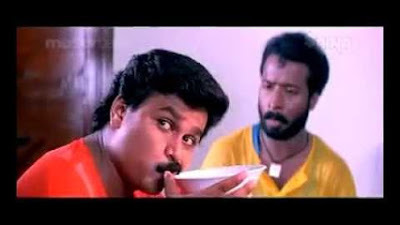 COLUMN: Location Diary
COLUMN: Location DiaryDirector Mecartin talks about his experience with a stunt man in 'Punjabi House'By Shevlin SebastianIt was the suicide scene in the evergreen Malayalam film, 'Punjabi House'. Feeling burdened by debts, Unni (played by Dileep) stands on the edge of the 150-year-old pier at Allapuzha Beach. The jump was 20 feet. But there was nothing to worry.A stunt man, Ravi, had come all the way from Chennai. He quickly changed into the same costume that Dileep was wearing: a maroon shirt and black trousers. Although Ravi was bald, he slipped on a black wig. “From a distance, he looked like Dileep,” says director Mecartin.Things were going smoothly, till Mecartin asked Ravi whether he had jumped from a pier. He replied in the negative. Then Mecartin asked him whether he knew swimming. “No Sir,” said Ravi. “This is my first time.”Ravi belonged to an union in Chennai. At that time Mollywood only used these men, who had health and life insurance. So, in case something untoward happened, it would be paid for. “These people had been trained to do shots where people can break a bottle over their heads,” says Mecartin. “Or they can jump through a glass-paned window. At that moment, I did not have the option of asking for someone else.”But Mecartin began to feel nervous. He looked at the sea. “It was very rough,” he says. “I did not know what to do.”Several youths were standing nearby hearing the discussions. Soon, they came up to Mecartin and told the director that they knew how to swim in these swift currents and could rescue Ravi after he jumped. After a brief talk with his crew, Mecartin agreed. He told them to wait beneath the pier, out of camera range.Meanwhile, as Ravi stood on the edge, cameras were placed on either side of him. All was ready. “Action,” shouted Mecartin, as Dileep watched keenly from a distance.Ravi jumped perfectly, hands and legs splayed, like a man who is about to commit suicide. Once he landed in the water, the director shouted, 'Cut”. On cue, the local boys swam forward and rescued the stunt man and brought him up to the surface.That was when Mecartin got a shock. “It was not the same person,” he says. “This man had a beard.” A frightened Mecartin thought, 'How did this happen? And where is Ravi? Has he drowned? And who is this man?'Mecartin's heart began to thud at high speed. The crew members also looked worried.But when the man was brought to the shore the answer became clear. In the water, Ravi's wig had slipped off and got stuck to the face. So that was how he looked different.
A relieved Mecartin, co-director Rafi, Dileep and the crew had a hearty laugh.
(The New Indian Express, Kochi and Thiruvananthapuram)
Published on November 10, 2015 21:15



